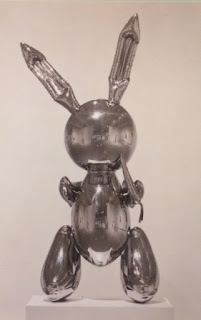I.
Clearly, Jeff Koons features as a very special kind of hate figure in the work of Byung-Chul Han.
Not only does he have an intense dislike for the ultra-smoothness of Koons's sculptural works - including his stainless steel Rabbit (1986), which, for Han, reflects a social imperative lacking in all negativity [2] - but he doesn't much care for Koons's paintings either.
Writing with reference to the Easyfun-Ethereal series in which a wide variety of things, including food items and human body parts, are assembled, Han says:
"His pictures mirror our society, which has become a department store. It is stuffed full of short-lived objects and advertisements. It has lost all otherness, all foreignness; thus it is no longer possible to marvel at anything. Jeff Koons's art, which merges seamessly with consumer culture, elevates consumerism to a figure of salvation." [3]
Well, maybe: but then, on the other hand, it could be that Koons's work is actually a critique of consumerism, exposing the false hopes, empty dreams, and the banality of the mass produced goods that the latter trades in.
If you don't want to buy that, then try this: maybe what Koons is attempting to do is give back to things their strangeness and inviting us to delight in the culture we inhabit - as is, and free from shame and snobbery. To assist in the overcoming of bad conscience - i.e., to allow people to take pleasure in the things they like without feeling guilty, or having to justify their tastes - would be a good thing, no?
II.
In the Easyfun-Ethereal series, Koons has cut and pasted (seemingly at random) pictues found in glossy magazines and old ads, as well as photographs of his own, creating digital collages that appear to be as chaotic as they are colourful.
Although initially this work is performed on a computer using Photoshop softwear, the electronic images are then transformed into traditional oil on canvas paintings, with painstaking photo-realist attention to detail; Koons and his team of assistants spend months meticulously applying computer-calibrated colours by hand.
The word traditional may seem an odd one to use with reference to Koons's paintings. But, as a matter of fact, that's exactly what his work is. Far from emerging out of nowhere, his paintings are rich in many elements that recall art history (and not just Pop art history). Unlike Han, I think there's much to marvel at in the windows of our great department stores - and much to marvel at in Koons's pictures too.
His canvases don't merely mirror our society, they also - more importantly - speak of what Levi Bryant termed the democracy of objects, i.e., a flat ontological realm wherein objects of all sorts - from hot dogs, elephants, and rollercoasters, to lips, wigs, and bikini bottoms - equally exist without being reducible to other objects and can dynamically interact outside of any transcendent system of meaning [4].
This, for me at least, gives Koons's work not only cultural and aesthetic interest, but philosophical import too. But readers can make up their own mind by visiting his website and viewing the twenty-four pictures - from Auto to Venus - that make up the Easyfun-Ethereal series: click here.
Notes
[1] This catalogue was published on the occasion of an exhibition that ran from 27 Oct 2000 - 14 Jan 2001, featuring
seven new works by Jeff Koons commissioned for the Deutsche Guggenheim
(Berlin). Illustrated with full-colour reproductions, the catalogue also includes an interview with the artist by David
Sylvester, as well as an essay by Robert Rosenblum analysing Koons's technique and imagery.
[2] See the post entitled 'On Smoothness' (5 Dec 2021): click here.
[3] Byung-Chul Han, The Expulsion of the Other, trans. Wieland Hoban, (Polity Press, 2018), p. 59.
[4] See: Levi R. Bryant, The Democracy of Objects, (Open Humanities Press, 2011).


